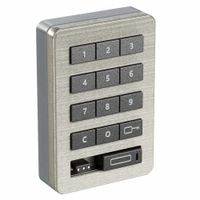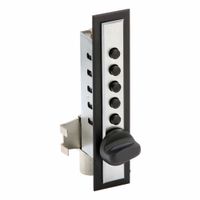Call +(254) 703 030 000 / 751 483 999 / 721 704 777
.....Read More
Frequently Asked Questions
What are keyless cabinet and locker entry products?
Keyless cabinet and locker entry products refer to security systems that allow access to cabinets and lockers without the need for a physical key. Instead of traditional locks and keys, these systems use various electronic or mechanical methods to grant entry. Common types include keypad locks, where a numerical code is entered; RFID (Radio-Frequency Identification) locks, which use cards or tags for access; biometric locks, which rely on fingerprints or other unique biological identifiers; and smart locks, which can be controlled via a smartphone app. These products offer enhanced convenience, as users don't need to carry or worry about losing keys. They also provide greater security features, such as audit trails to track access, the ability to easily change access codes, and the flexibility to grant or revoke access remotely. Keyless entry systems are widely used in a variety of settings, including offices, gyms, schools, hospitals, and homes, for securing personal belongings, sensitive documents, and valuable equipment. They streamline access management and can be integrated into larger security networks for comprehensive control.
How do electronic keyless cabinet locks work?
Electronic keyless cabinet locks offer enhanced security and convenience compared to traditional key-based systems. They typically operate using a keypad for code entry, an RFID reader for card access, or Bluetooth for smartphone control.
When a valid code is entered or a recognized credential is presented, the lock's internal circuitry verifies the input. If authentication is successful, a small motor or solenoid within the lock mechanism is activated. This action retracts or disengages a bolt or latch, allowing the cabinet door to open. The lock usually re-engages automatically after a set time or when the door is closed.
These locks are powered by batteries and often include low-battery indicators. Some advanced models may also feature audit trails, logging entry attempts and access times, which is particularly useful for tracking access in commercial or shared environments. The absence of physical keys eliminates concerns about lost or duplicated keys, streamlining access management.
What are the benefits of using keyless locks for cabinets and lockers?
Keyless locks offer numerous advantages for cabinets and lockers, enhancing convenience, security, and management. One significant benefit is the elimination of physical keys, which can be lost, stolen, or misplaced, leading to costly replacements and security risks. With keyless systems, access is gained through codes, biometrics, or smart cards, reducing the hassle of key management and distribution.
From a security perspective, keyless locks provide a higher level of protection. Many systems offer audit trails, allowing administrators to track who accessed a locker or cabinet and when, which is invaluable for accountability and investigating security breaches. Codes can be changed frequently, especially for shared or temporary use, ensuring that old access credentials are no longer valid. Some advanced systems also feature tamper alerts, notifying users or security personnel of unauthorized access attempts.
For management, keyless locks simplify access control. Granting or revoking access to multiple users becomes a streamlined process, often manageable through a central system. This is particularly beneficial in environments with high user turnover, such as gyms, schools, or offices. Additionally, the durability of keyless mechanisms often surpasses that of traditional keyholes, leading to reduced maintenance and repair costs over time. Overall, keyless locks provide a modern, efficient, and secure solution for managing access to cabinets and lockers.
Are keyless cabinet locks secure?
Keyless cabinet locks offer a modern and often convenient alternative to traditional keyed locks, but their security can vary significantly depending on the type and quality of the lock.
Many keyless cabinet locks, such as those that use RFID, PIN codes, or fingerprint recognition, can provide a good level of security for typical household or office use. For instance, a well-designed RFID lock can be difficult to pick, and a strong PIN code is challenging to guess. Biometric locks, like fingerprint scanners, offer a high level of personalized security, as they rely on unique physical attributes.
However, no lock is completely foolproof. The security of keyless locks can be compromised through various methods, including bypassing the electronic mechanism, guessing simple PINs, or using brute-force methods on cheaper models. For example, some less expensive electronic locks might be vulnerable to electromagnetic interference or simple reset procedures that can grant unauthorized access. Furthermore, the physical construction of the cabinet and the lock's mounting also play a crucial role in its overall security. A strong lock on a flimsy cabinet will not provide much protection.
For sensitive items or high-security needs, it is advisable to choose keyless cabinet locks from reputable brands that incorporate advanced encryption and anti-tamper features. Regular updates for smart locks and strong, unique PINs are also essential for maintaining security.
How long do the batteries last in electronic keyless locks?
The battery life of electronic keyless locks varies depending on several factors, including the type of lock, frequency of use, battery quality, and environmental conditions. Generally, you can expect batteries in most electronic keyless locks to last anywhere from 6 months to 2 years.
More frequently used locks, such as those on a main entry door, will drain batteries faster than locks used less often, like a back gate. Features such as illuminated keypads, Wi-Fi connectivity, or smart home integration can also significantly impact battery life due as they require more power. Using high-quality alkaline batteries is recommended, as they typically offer better longevity compared to cheaper alternatives. Some locks also have indicators that alert you when the battery power is low, allowing you to replace them before the lock completely loses power.
Can keyless locks be installed on any type of cabinet or locker?
Keyless locks can be installed on many types of cabinets and lockers, but compatibility can vary. Most keyless locks are designed to fit standard cabinet and locker door thicknesses and existing boreholes. However, factors such as material (wood, metal, glass), door thickness, and the presence of existing hardware can influence installation. Some specialized keyless locks are designed for specific applications, like glass doors or particularly thick materials. It's always best to check the product specifications and consult with the manufacturer or a professional installer to ensure compatibility with your specific cabinet or locker type.
What happens if the battery dies in an electronic keyless lock?
When the battery dies in an electronic keyless lock, you typically won't be locked out. Most electronic keyless locks are designed with backup methods to ensure you can still gain entry. A common solution is a physical key override, where you can use a traditional key to unlock the door, similar to a standard deadbolt. Many locks also have a terminal for a 9-volt battery, allowing you to temporarily power the lock from the outside to enter a code and unlock the door. Some advanced models might even have micro-USB ports for temporary power. It's important to replace the batteries proactively when you receive low-battery warnings to avoid these situations, but manufacturers generally include these backup options for user convenience and security.
How do you reset a combination on a mechanical keyless lock?
To reset a combination on a mechanical keyless lock, the exact steps can vary depending on the specific model and manufacturer. However, a common method involves finding the "reset" or "change" button/lever, which is often located on the interior side of the lock or within the mechanism.
**General steps often include:**1. **Locate the Reset Mechanism:** This might be a small button that needs to be pressed with a pen or a lever that needs to be shifted.
2. **Enter Current Combination (if applicable):** Some locks require you to enter the current working combination before you can initiate the reset process.
3. **Activate Reset Mode:** Once the reset mechanism is engaged, the lock is typically in a "reset" or "programming" mode.
4. **Enter New Combination:** While in reset mode, you will then enter your desired new combination.
5. **Deactivate Reset Mode:** After entering the new combination, you'll usually need to disengage the reset mechanism (e.g., release the button, shift the lever back).
6. **Test the New Combination:** Before fully relying on the new combination, always test it a few times with the door open to ensure it works correctly.**Important Considerations:** * **Manufacturer's Instructions:** Always refer to the specific instruction manual that came with your lock. This is the most reliable source for accurate reset procedures.
* **Security:** When choosing a new combination, select one that is easy for you to remember but difficult for others to guess.
* **Professional Help:** If you've lost the instructions or are having trouble, contact the lock manufacturer's customer support or a qualified locksmith.
Are there any maintenance requirements for keyless cabinet locks?
Keyless cabinet locks generally require minimal maintenance, but there are a few things to keep in mind to ensure their longevity and proper function. Regularly check the battery levels and replace them as needed, typically every 6-12 months, depending on usage. For electronic locks, keeping the keypad clean and free of dust or debris is important. You can wipe it down with a soft, damp cloth. For mechanical or combination locks, occasionally lubricating the moving parts with a silicone-based spray can help prevent sticking. Avoid using oil-based lubricants, as they can attract dirt. Periodically check that all screws and mounting hardware are secure. If the lock is exposed to moisture or extreme temperatures, consider more frequent inspections to prevent corrosion or damage.
Can keyless locks be used in outdoor environments?
Yes, keyless locks can be used in outdoor environments, but their suitability depends on several factors, primarily the lock's design and features. Many manufacturers produce keyless locks specifically engineered for outdoor use, often incorporating robust materials and weather-resistant seals.
When considering an outdoor keyless lock, look for models with an IP (Ingress Protection) rating, which indicates their resistance to dust and water. A higher IP rating (e.g., IP65, IP66, or IP67) signifies better protection against the elements. Materials like zinc alloy, stainless steel, and hardened plastic are commonly used for their durability and corrosion resistance.
Additionally, the type of keyless lock matters. Mechanical push-button locks are often very durable outdoors as they don't rely on electronics. Electronic keypads or smart locks for outdoor use should have encapsulated electronics to prevent moisture ingress and be designed to withstand extreme temperatures. Some smart locks also offer features like anti-corrosion coatings and internal heaters for very cold climates. Battery life and ease of battery replacement are also considerations for electronic outdoor locks.

